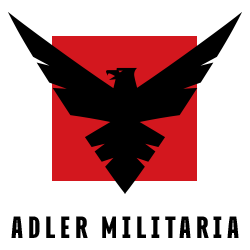Showing 289–297 of 1325 resultsSorted by latest
-

WWI US Army AEF Grouping – Corporal Kenneth D Eastman – 81st Division – Victory Medal Meuse-Argonne & Defensive Sector – Oregon State Victory Medal – Brotherhood of Fireman & Enginemen Medal for Service in the World War
1) Patches including two 81st Divisional Shoulder Sleeve Patches, Corporal Chevrons, Infantry Specialty Patch, Gold Overseas Strip and finally a Red Discharge Stripe. 2) Studio portrait of Kenneth D. Eastman 3) Buttons cut from his uniform as well as his cap device 4) Collar Disk including two Crossed Rifles Infantry Disk, USNA and US Collar Disks and 321 Infantry G Disk. 5) Dog Tags Named to Kenneth D. Eastman 6) Medals including Victory medal with two bars Meuse-Argonne and Defensive Sector. Oregon State Victory Medal, Brotherhood of Fireman & Enginemen Medal for Service in the World War, Expert Rifleman Badge and lastly his Discharge lapel Button. The 81st Division was organized as a division of the United States Army in August 1917 during World War I at Camp Jackson, South Carolina. The division was originally organized with a small cadre of Regular Army, in addition to Officers Reserve Corps and National Army officers, while the soldiers were predominantly Selective Service men drawn from the southeastern states of Florida, North Carolina, and Tennessee. During October 1918, most of the enlisted men were transferred to other units, but additional drafts from Alabama, Florida, Georgia, North Carolina, South Carolina, and Tennessee replenished the strength of the division. After finishing training, the 81st Division, commanded by Major General Charles Justin Bailey, deployed to Europe, arriving on the Western Front in August 1918. Elements of the 81st Division first saw limited action by defending the St. Dié sector in September and early October. After relief of mission, the 81st Division was attached to the American First Army in preparation for the Meuse-Argonne Offensive. In the last days of World War I, the 81st Division attacked a portion of the German Army’s defensive line on 9 November 1918, and remained engaged in combat operations until the Armistice with Germany at 1100 hours on 11 November 1918. The division sustained 461 casualties on the last day, 66 of them killed. After the cessation of hostilities, the 81st Division remained in France until May 1919; after which the division was shipped back to the United States and inactivated on 11 June 1919.
-

WWI US Army AEF Grouping – Private Thomas J Kennedy – 26 Division – 2nd Infantry Mass (104th Infantry) – Purple Heart – Aisne Marne- St Mihiel – Meuse Argonne
$475.00WWI Grouping to Thomas J. Kennedy of Holyoke Mass. who served with Co. D. 104th Infantry of the 26th Division. 1) 5 placement Winged Victory Medal with Champaign-Marne, Aisne-Marne, St. Mihiel, Meuse-Argonne and Defensive Sector 2) Unnamed Purple Heart with replaced ribbon and missing Brooch, 3) Holyoke Mass Victory Medal 4) Welcome Home 26th Division Reunion Ribbon Victory in Paris Handkerchief. The grouping is attributed to Thomas J. Kennedy of Holyoke Mass. who served with Co. D. 104th Infantry of the 26th Division. Overseas On 21 September 1917, the division arrived at Saint-Nazaire, France. It was the second division of the American Expeditionary Forces (AEF) to arrive on the Western Front at the time, and the first division wholly organized in the United States, joining the 1st Division, which had arrived in June. Two additional divisions completed the first wave of American troop deployment, with the 2nd Division being formed in France and the 42nd Division arriving at St. Nazaire on 29 October. The 26th Division immediately moved to Neufchâteau for training, as most of the division’s soldiers were raw recruits, new to military service. Because of this, much of the division’s force was trained by the experienced French forces. It trained extensively with the other three US divisions, organized as the U.S. I Corps in January 1918, before being moved into a quiet sector of the trenches in February. The 26th Infantry Division remained in a relatively quiet region of the lines along the Chemin des Dames for several months before it relieved the 1st Division near Saint-Mihiel on 3 April. The line here taken over extended from the vicinity of Apremont, on the west, in front of Xivray-Marvoisin, Seicheprey, and Bois de Remieres, as far as the Bois de Jury, on the right, where the French line joined the American line. Division Headquarters were at Boucq. The stay of the division in this sector was marked by several serious encounters with the enemy, where considerable forces were engaged. There were furthermore almost nightly encounters between patrols or ambush parties, and the harassing fire of the artillery on both sides was very active. On 10, 12 and 13 April, the lines held by the 104th Infantry in Bois Brule (near Apremont), and by the French to the left, were heavily attacked by the Germans. At first the enemy secured a foothold in some advanced trenches which were not strongly held, but sturdy counterattacks succeeded in driving the enemy out with serious losses, and the line was entirely re-established. In late April, German infantry conducted a raid on positions of the 26th Division, one of the first attacks on Americans during the war. At 0400 on 20 April, German field artillery bombarded the 102nd Infantry’s positions near Seicheprey before German Storm Troopers (German: Stoßtruppen) moved against the village. The artillery box barrage, continuing 36 hours, isolated American units. The Germans overwhelmed a machine gun company and two infantry companies of the 102nd and temporarily breached the trenches before elements of the division rallied and recaptured the village. The Germans withdrew before the division could counterattack but inflicted 634 casualties, including 80 killed, 424 wounded, and 130 captured, while losing over 600 men, including 150 killed of their own. Similar raids struck the 101st infantry at Flirey on 27 May, and the 103rd Infantry at Xivray-et-Marvoisin on 16 June, but were repulsed. The 26th Division was relieved by the 82nd Division on 28 June, moved by train to Meaux, and entered the line again northwest of Chateau Thierry, relieving the 2nd Division on 5 July. As the size of the AEF grew, the division was placed under command of I Corps in July. When the Aisne-Marne campaign began shortly thereafter, the division, under I Corps was placed under command of the French Sixth Army protecting its east flank. When the offensive began, the division advanced up the spine of the Marne salient for several weeks, pushing through Belleau Wood, moving 10 miles from 18 to 25 July. On 12 August it was pulled from the lines near Toul to prepare for the next offensive. The division was then a part of the offensive at Saint-Mihiel, during the Battle of Saint-Mihiel. The division then moved in position for the last major offensive of the war, at Meuse-Argonne. This campaign was the last of the war, as an armistice was signed shortly thereafter. During World War I the 26th Division spent 210 days in combat, and suffered 1,587 killed in action and 12,077 wounded in action. The division returned to the United States and was demobilized on 3 May 1919 at Camp Devens, Massachusetts.
-
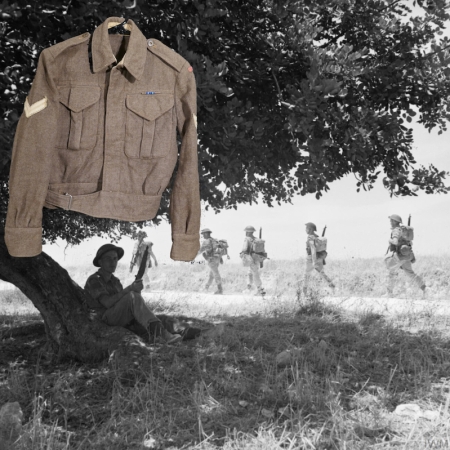
WWII Canadian Battle Dress Blouse – Maker Marked Feb 1944 – Corporal in the 1st Canadian Division – Gothic Line Italy 1944 – Netherlands 1945 – Original
I have not really found many of these of the years but this one with the Red Flash for the 1st Canadian and early 1944 production and clearly worn, all insignia was on it when found. Nicely Maker marked. The Battle History of the Unit: After this the division was rested and many months of static warfare ensued, the division then went on to break out of the Eighth Army’s bridgehead with the second wave in the spring offensive, Operation Diadem, the Fourth Battle of Monte Cassino. The 4th Princess Louise Dragoon Guards, the reconnaissance (or ‘recce’) regiment serving with the 1st Canadian Division, was the first of the Eighth Army’s units to cross the Hitler Line in May 1944, below Pontecorvo in its armoured cars. After heavy fighting in front of the Gothic Line throughout the summer, the 1st Canadian Infantry Division spent the next several months fighting, as it had the previous fall, for a succession of heavily defended river crossings surrounded by high ground. By the time the division reached the Senio, as the icy rain began giving way to snow in the Canadian sector, a decision had been reached to transfer the entire I Canadian Corps, 1st Infantry Division included, to the Netherlands. By the end of March 1945 all Canadian Army units serving with Allied Forces Mediterranean (formerly the Allied Armies in Italy) had been transferred to the Western Front and Operation Goldflake, the reunion of the 1st Infantry Division and 1st Armoured Brigade and First Canadian Army, commanded by Lieutenant-General Harry Crerar, was accomplished. The division, now under Major General Harry Foster, went on to take part in the Western Allied invasion of Germany, the liberation of a majority of the Netherlands including the liberation of Arnhem, and the war in Europe came to an end soon after, on 8 May 1945, Victory in Europe Day. The headquarters of the 1st Canadian Infantry Division was officially disbanded on 15 September 1945.
-
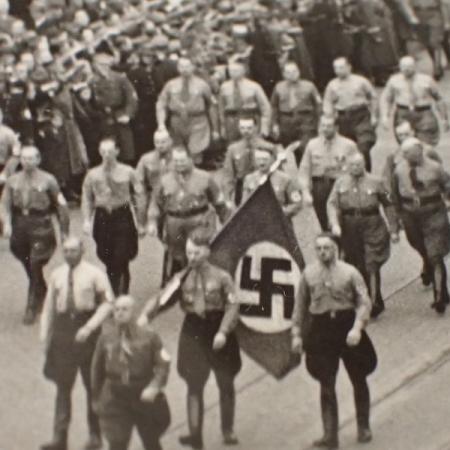
WWII Original Photo – Hitler – Streicher – Himmler – Blutfahne – München – Feldhernhalle – 9 November 1937 – Blood Order – Blood Flag – Rare
$250.00This photo depicts the Munich 9th of 9 November 1937 March to the Feldhernhalle. This is a period photo and was taken by a prewar photographer reporting on rhe event. Not many photos of this procession unless it was someone close up to see what was going on at the front.
-
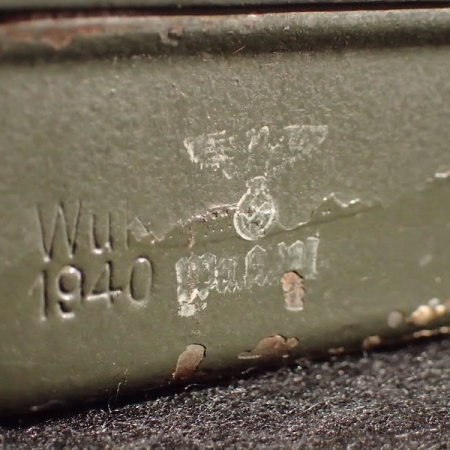
WWII German Army Marked Stick Grenade EMPTY Fuze Box – WaA101 – Metal Goods Weapons Inspection – Rare
$135.00A small but hard to find item, this box was formerly a fuze box. Similar Inspection marks come up with the German Stick Grenade Box Internals as well as Stick Grenade Parts. WaA101
-
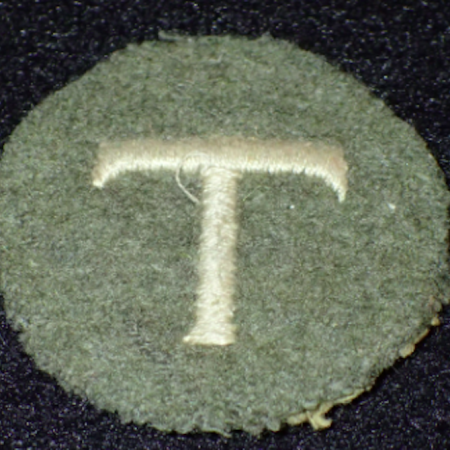
WWII German Organisation Todt T Patch – Original Rare
This recently came up on other sites and we are going by what we have seen. This seems to be a Patched Identified as used with the Organisation Todt.
-

WWII German Soldbuch – Unteroffizier Karl Zöttl – Grenadier Regiment 688 – Machine Gunner -377 Inf Div – Hit in the Head Lost Leg in Battle – Iron Cross Second Class – Original (Sold)
Soldbuch issued in January 1942 with a training unit. To, Karl zötl born in 1921 in Munich Germany, worked as a hair dresser before the war, of catholic denomination. Frontlien Unit: Grenadier Regiment 690 Grenadier Regiment 688 ( Machine Gun Company) The 337th Infantry Division (German: 337. Infanterie-Division) was a German Army infantry division in World War II. It was formed on 16 November 1940 in Kempten. The division was destroyed on the Eastern front in July 1944 and formed the staff and core personnel of Divisionsgruppe 337 on 7 August 1944 which later was the basis of the 337th Volksgrenadier-Division. Issued Field Rations Iron, Camo Uniform, New Tog Tag, as well as diverse winter kit. Karl was hit with Grenade Shrapnel in the face left eye and nose and lost his left leg, , it seems this would knock him out of the war completely – for which he was also upgraded awarded the Wounds Badge in Silver and the Iron Cross Second Class.
-
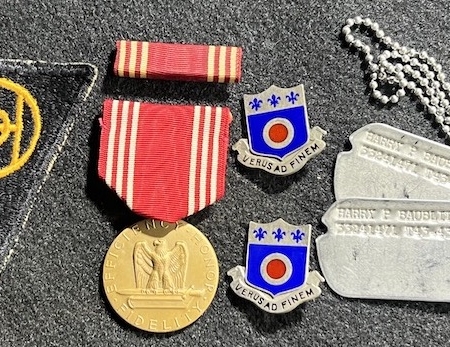
WWII US Army Jewish GI Grouping – Private Harry P Baublitz – 83rd Infantry Division – Wounded Pistol Bullet Leg Normandy France 1944 – Wounded with Shrapnel Ardennes 1944 – Rare
Baublitz served with the 83rd Infantry Division, he was wounded in Normandy in July 1944 by a Pistol bullet in the leg, he rejoined his unit and was wounded once again in December n the Ardennes with grenade splinters. Enlistment Name Harry P Baublitz Race White Marital Status Single, without dependents (Single) Rank Private Birth Year 1919 Nativity State or Country Pennsylvania Citizenship Citizen Education Grammar school Civil Occupation Unskilled occupations in manufacture of furniture, n.e.c. Enlistment Date 30 Sep 1942 Enlistment Place Harrisburg, Pennsylvania Service Number 33241471 Branch Branch Immaterial – Warrant Officers, USA Component Selectees (Enlisted Men) Source Civil Life Height 68 Weight 119 Hospital Entry Record Name Harry P Baublitz Race White, includes Mexican (White) Rank Enlisted Man Admission Age 25 Birth Date abt 1919 Admission Date Jul 1944 Discharge Date Aug 1944 Military Branch Infantry, General or Unspecified Diagnosis FirstLocation: Leg; SecondDiagnosis: Cellulitis; SecondLocation: Leg; ; CausativeAgent: Bullet, Pistol or Revolver Type of Injury Casualty, battle Medical Treatment Removal of foreign bodies from extremity Injured in Line of Duty In line of duty Type of Discharge Duty Length of Service 1 Year(s), 9, 10 OR 11 MONTHS Month(s) Service Number 33241471 Hospital Entry Record Name Harry P Baublitz Race White, includes Mexican (White) Rank Enlisted Man Admission Age 25 Birth Date abt 1919 Admission Date Dec 1944 Discharge Date Jan 1945 Military Branch Infantry, General or Unspecified Diagnosis FirstLocation: Buttock and hip; SecondLocation: Arm; ; CausativeAgent: Artillery Shell, Fragments, Afoot or unspecified Type of Injury Casualty, battle Medical Treatment Closure of wound, delayed (suture, secondary to wound) (delayed closure) Injured in Line of Duty In line of duty Type of Discharge Duty Length of Service 2 Year(s), 5 Month(s) Service Number 33241471 The 83d Infantry Division arrived in England on 16 April 1944. After training in Wales, the Division landed at Omaha Beach, 18 June 1944, and entered the hedgerow struggle south of Carentan, 27 June. Taking the offensive, the 83d reached the St. Lo-Periers Road, 25 July, and advanced 8 miles against strong opposition as the Normandy campaign ended. After a period of training, elements of the Division took Chateauneuf, 5 August, and Dinard, 7 August, and approached the heavily fortified area protecting St. Malo. Intense fighting reduced enemy strong points and a combined attack against the Citadel Fortress of St. Servan caused its surrender, 17 August. While elements moved south to protect the north bank of the Loire River, the main body of the Division concentrated south of Rennes for patrolling and reconnaissance activities. Elements reduced the garrison at Ile de Cezembre, which surrendered, 2 September. The movement into Luxembourg was completed on 25 September. Taking Remich on the 28th and patrolling defensively along the Moselle, the 83d resisted counterattacks and advanced to Siegfried Line defenses across the Sauer after capturing Grevenmacher and Echternach, 7 October. As the initial movement in operation “Unicorn,” the Division took Le Stromberg Hill in the vicinity of Basse Konz against strong opposition, 5 November, and beat off counterattacks. Moving to the Hurtgen Forest, the 83d thrust forward from Gressenich to the west bank of the Roer. It entered the Battle of the Bulge, 27 December, striking at Rochefort and reducing the enemy salient in a bitter struggle. The Division moved back to Belgium and Holland for rehabilitation and training, 22 January 1945. On 1 March, the 83d advanced toward the Rhine in the operation “Grenade,” and captured Neuss. The west bank of the Rhine from North of Oberkassell to the Erft Canal was cleared and defensive positions established by 2 March and the Division renewed its training. The 83d crossed the Rhine south of Wesel, 29 March, and advanced across the Munster Plain to the Weser, crossing it at Bodenwerder. As opposition disintegrated, Halle fell on 6 April. The Division crossed the Leine, 8 April, and attacked to the east, pushing over the Harz Mountain region and advancing to the Elbe at Barby. That city was taken on the 13th. The 83d established a bridgehead over the river but evacuated the area to the Russians on 6 May 1945. Last two photo for reference only from the web.
-
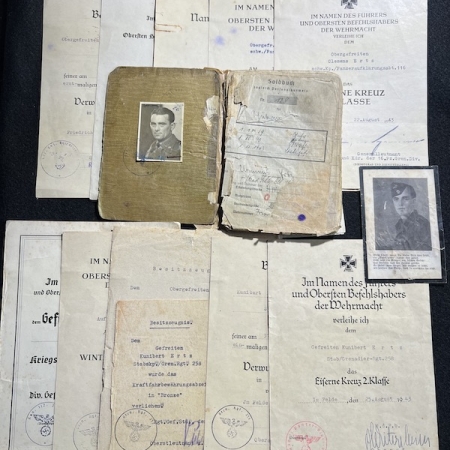
WWII German Three Brothers Grouping – Clemens, Kunibert and Anton Ertz – Waffen SS KIA in Caen, Normandy – Panzer Recon Der Windhund – Panzer A.A 116 – Soldbuch Urkunden Iron Cross Signatures – Rare Grouping
An incredible lot to three brothers: Stabsgefreiter Clements Ertz (Panzer Recon 116 – Der Windhund) Born in 1916, he would fight in the Machine Gun Section, of the Krad Schutzen Batl 165 – Fighting in Russia. Unit was equipped with Motor Bikes and Sidecars. Later moved into the Heavy Company Panzer Recon 116 (schw.Kp/ Panzeraufklärungsabt 116) (Windhund) He was issued with a MP40, and won the following awards as per the Soldbuch: West Wall Medal 1940 – With Certificate War Merit Cross With Swords – August 1941 – Signed by Generalmajor Generalleutnant Johannes Streich (Knights Cross) Commander of the 16th Infanterie Division Eastern Front Medal – Panzer Recon Abt 116 – Signed by Abt Leader . Iron Cross Second Class – August 1943 – Signed by Generallt Gerhard Helmut Detleff Graf von Schwerin (23 June 1899 – 29 October 1980) was a German General der Panzertruppe during World War II (Knights Cross Oak & Swords) Drivers Badge – Panzer recon 116 – All three grades till Gold It seems he fought with them till around late in 1943, note the Soldbuch photo in the Panzer or StuG Wrap as collectors call them where he falls ill, this means he is moving in and out of service. The Windhund have an amazing Battle History and were one of the most interesting Heer Units fighting on both fronts. Comes with his RAD Paper and the POW release Paper. Interestingly he used this as evidence for his War Pension in 1954. https://en.wikipedia.org/wiki/116th_Panzer_Division_(Wehrmacht) Next Brother : SS Sturmmann Anton Ertz – Waffen SS – Likely with the Hitlerjugend KIA in Caen on the 19th of July 1944 – he was buried in St honovine, but was called according to the archives in Germany as killed in : Amaye near Caen and is buried today in La Cambe. According to his death Card, he was a Messanger on a Motorbike and was awarded the Assault Badge. He was 18 years old when he was killed in action. Next Brother: Kunibert Erz – He served with the Recon Abteilung 120 (A.A 120) fighting in Russia, he was awarded the following awards: War Merit Cross – A.A 120 – 1942 – Signed 112 Infanterie Division Commander – Generallt Friedrich Mieth (4 June 1888 – 2 September 1944) was a German general during World War II. In 1942, he commanded Army Group Don Rear Area.[1] Mieth was killed in action on 2 September 1944 in Iași, Romania. Knights Cross Oak & Swords) KIA Rare signature. Eastern Front Medal – A.A 120 – Signed by Hauptmann and Regiment Commander of the Grenadier regiment 258 Drivers Badge in Bronze (Soldbuch Insert) and Drivers badge in Gold – Grenadier Regiment 258 Wounds Badge in Black – Grenadier regiment 258 – Signed Oberst and regimental Commander Iron Cross Second Calss – August 1943 – Grenadier Regiment 258 – Signed by an Oberst . It seems that Kunnibert went missing in January 1945 in the East of Germany and he was never found. Last Comments Quite the story of a sad reality, From the Three Brothers only one made it home. A rare grouping touching both the Western and Eastern Front and some of the most formidable battles in Normandy.
